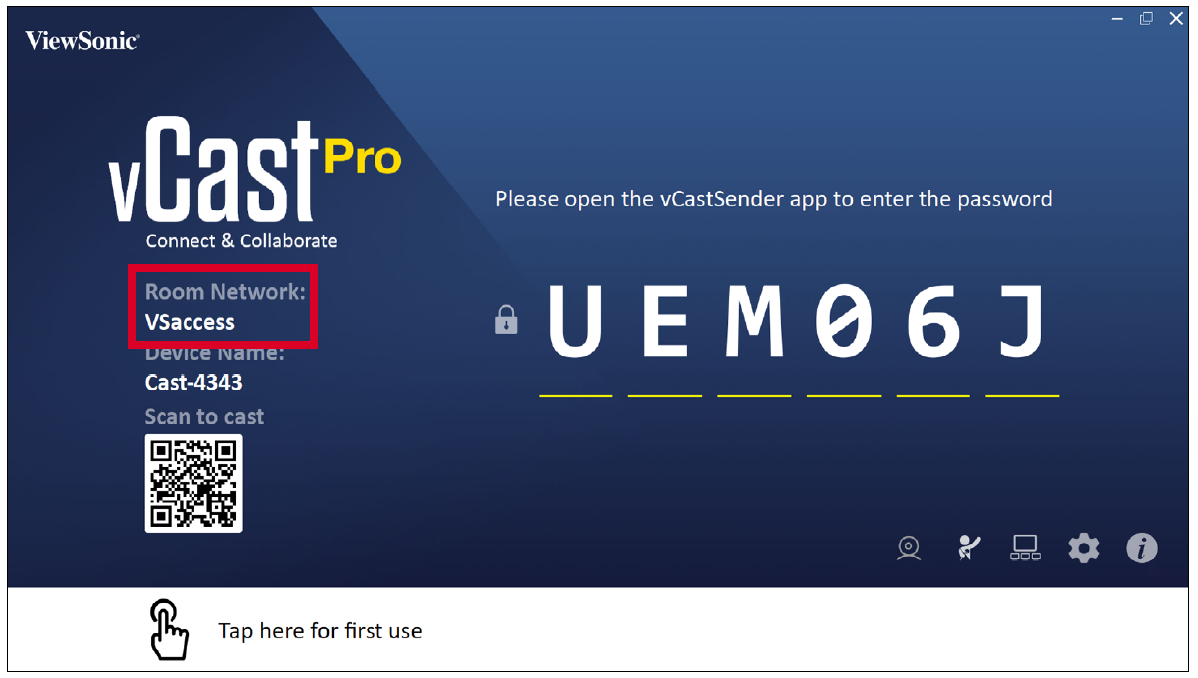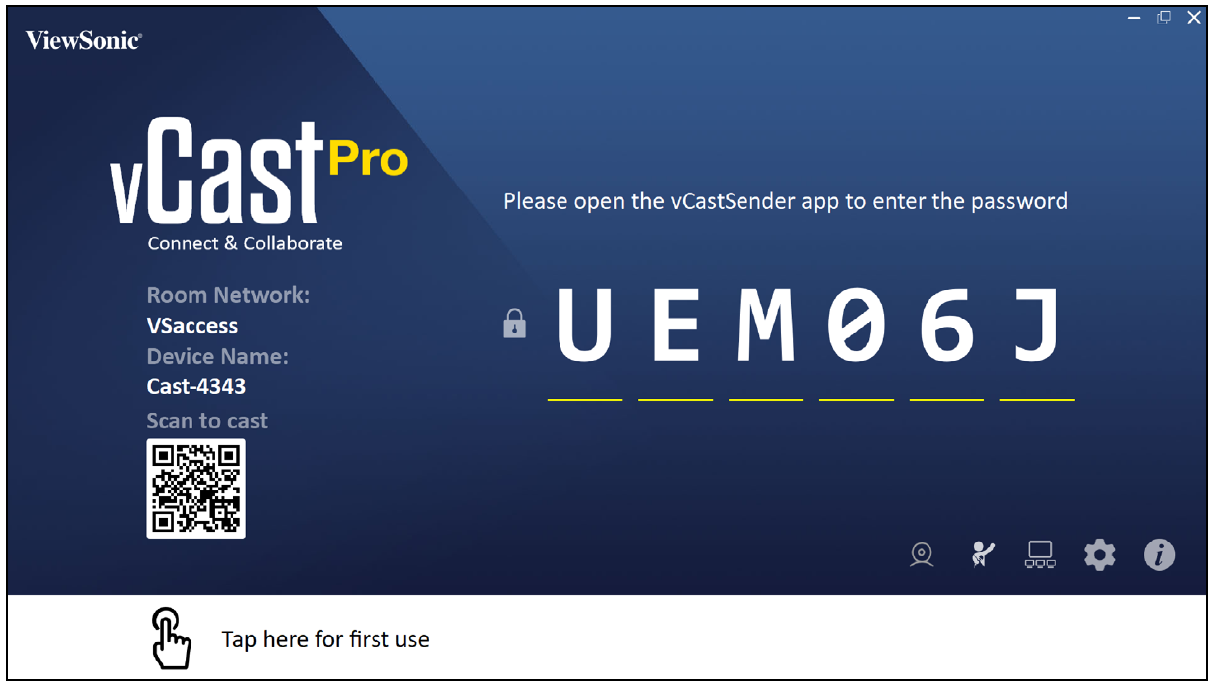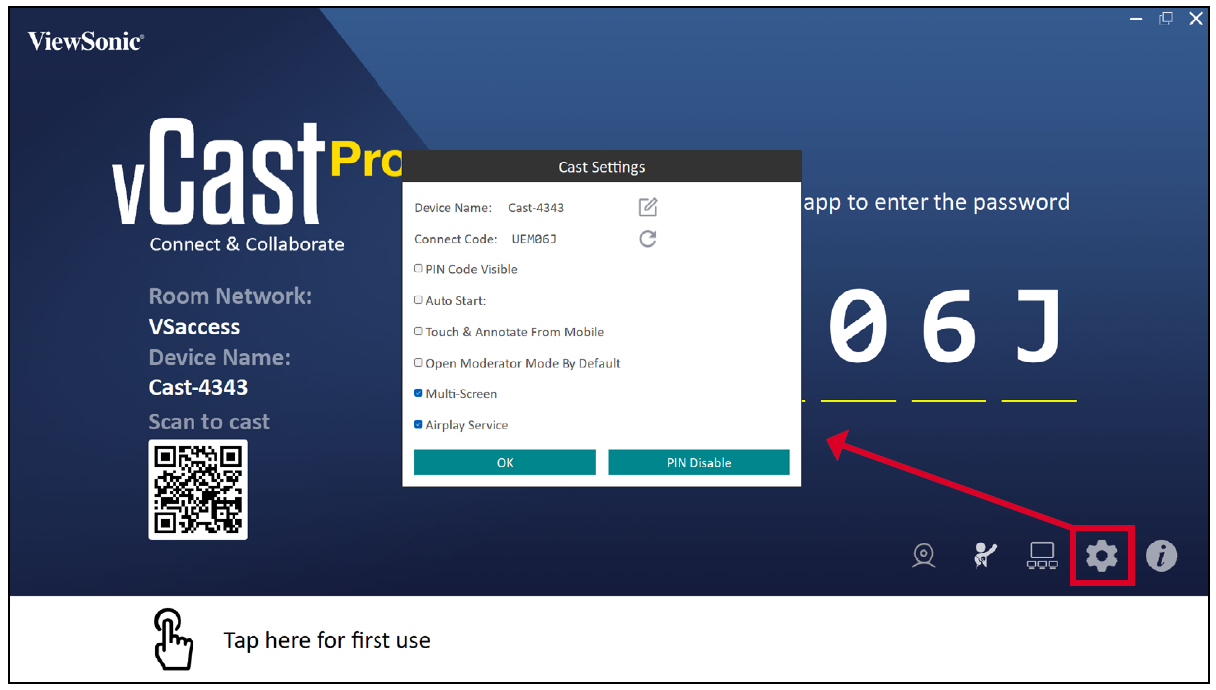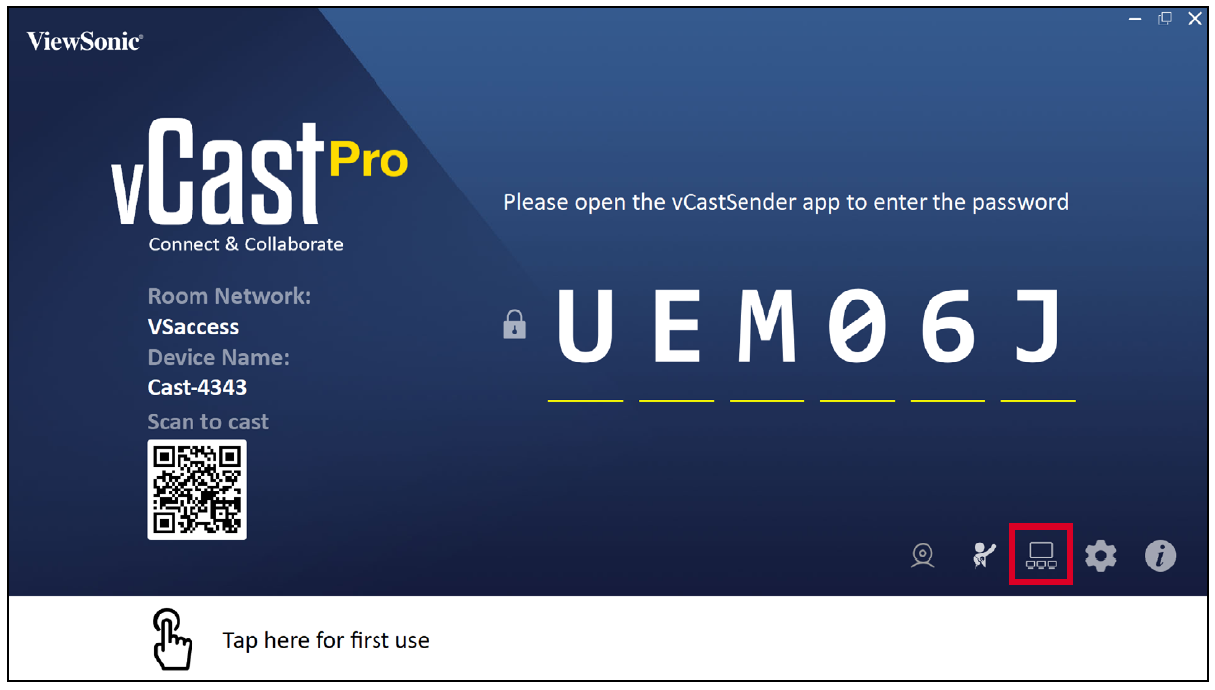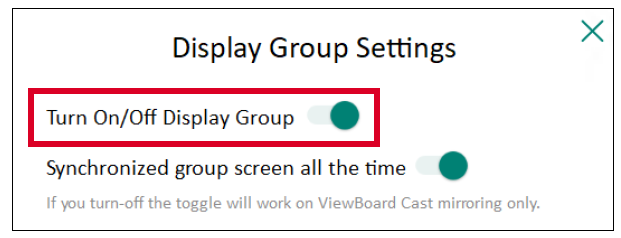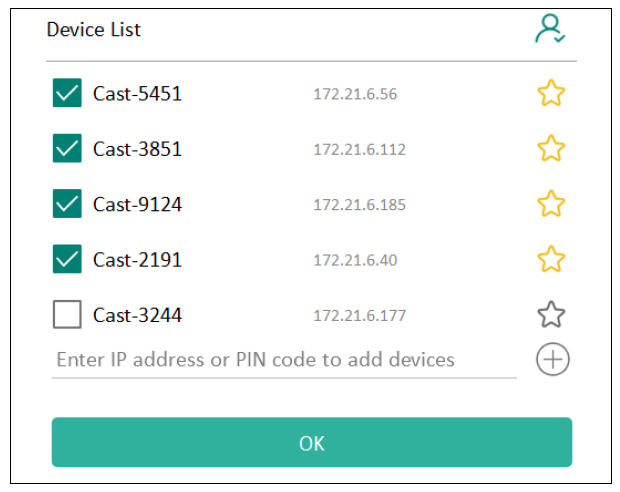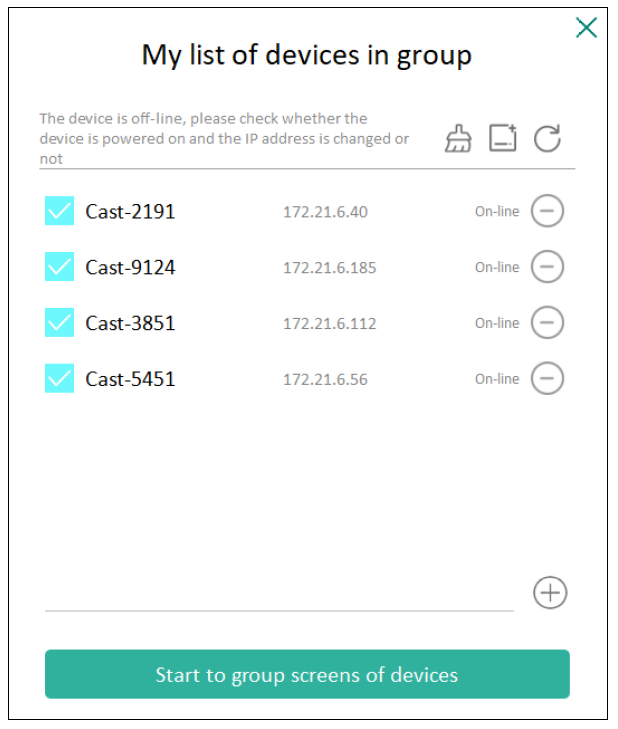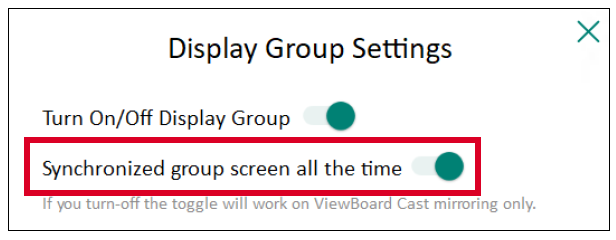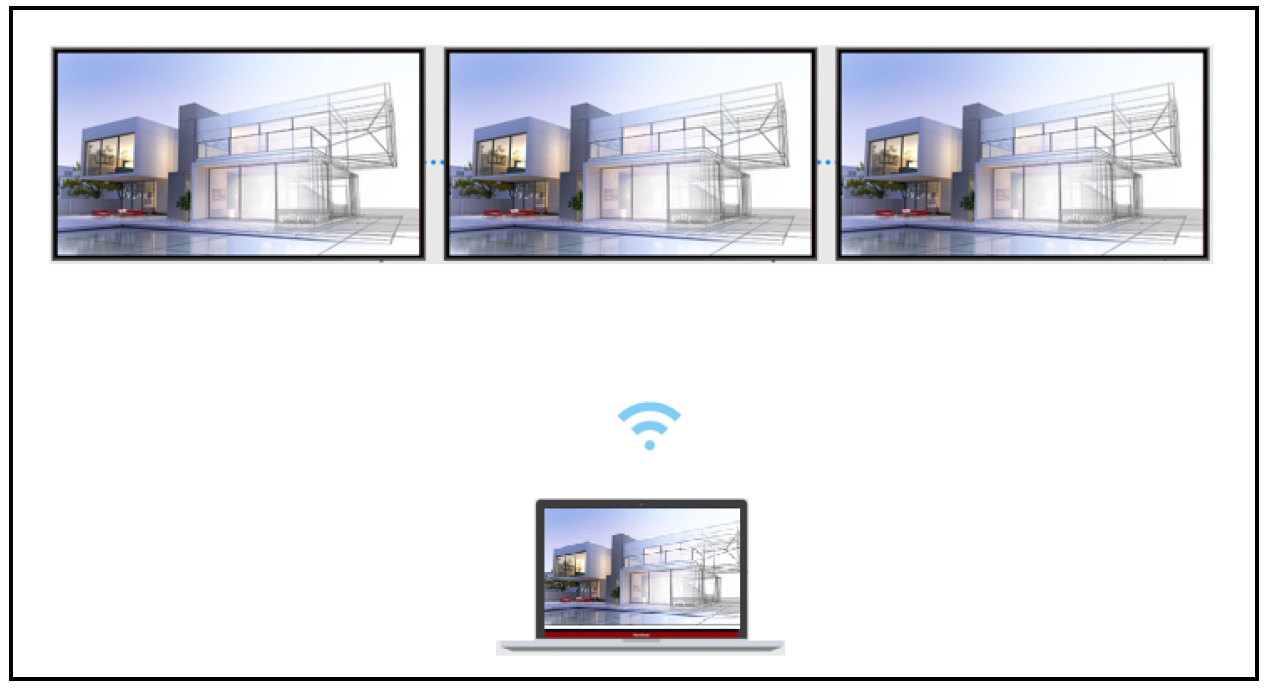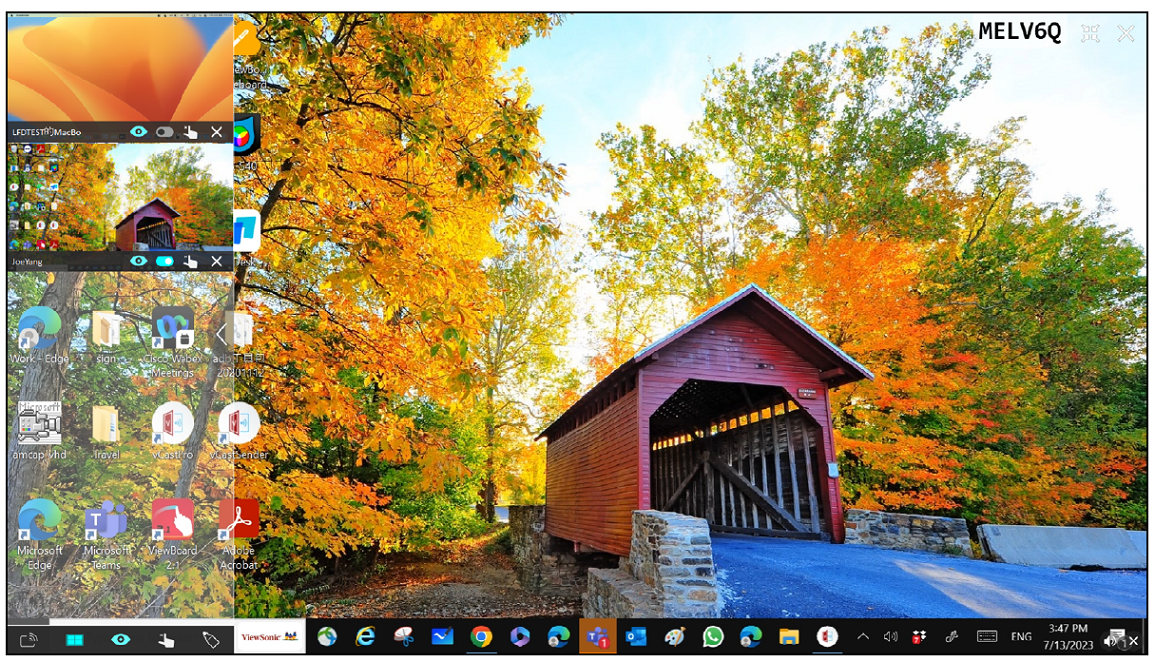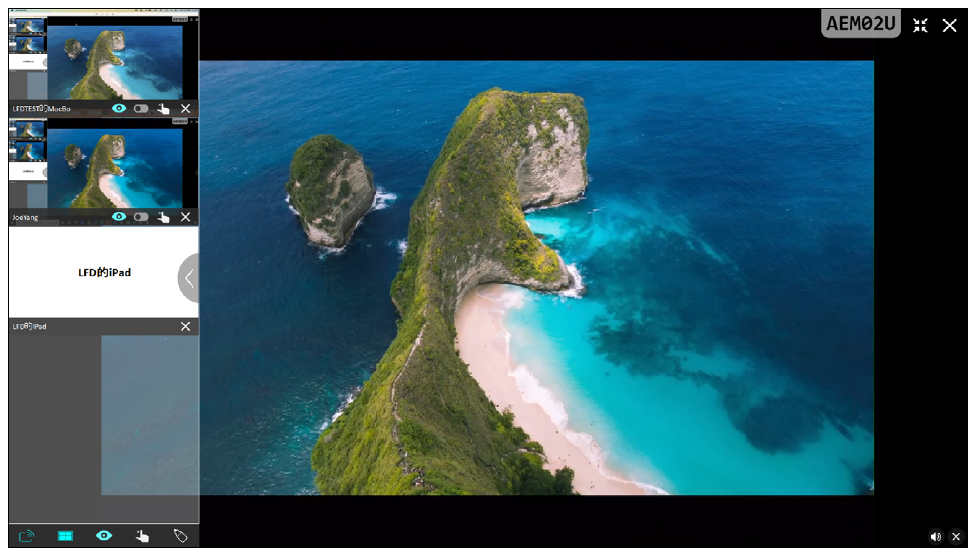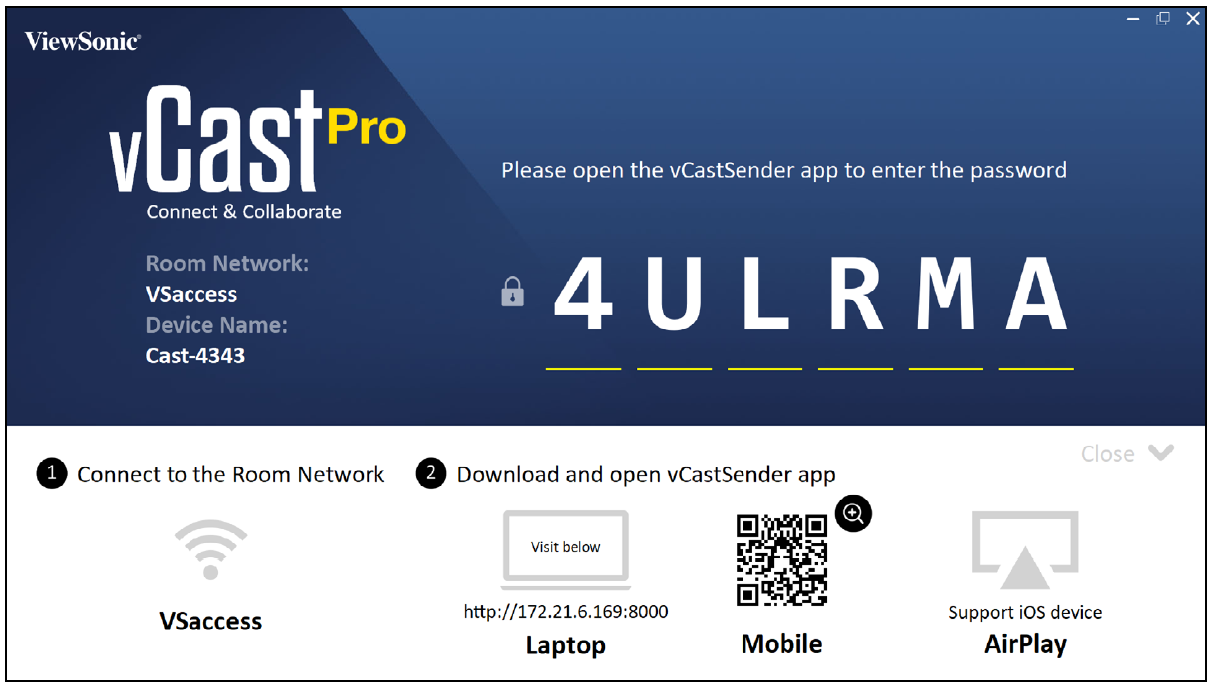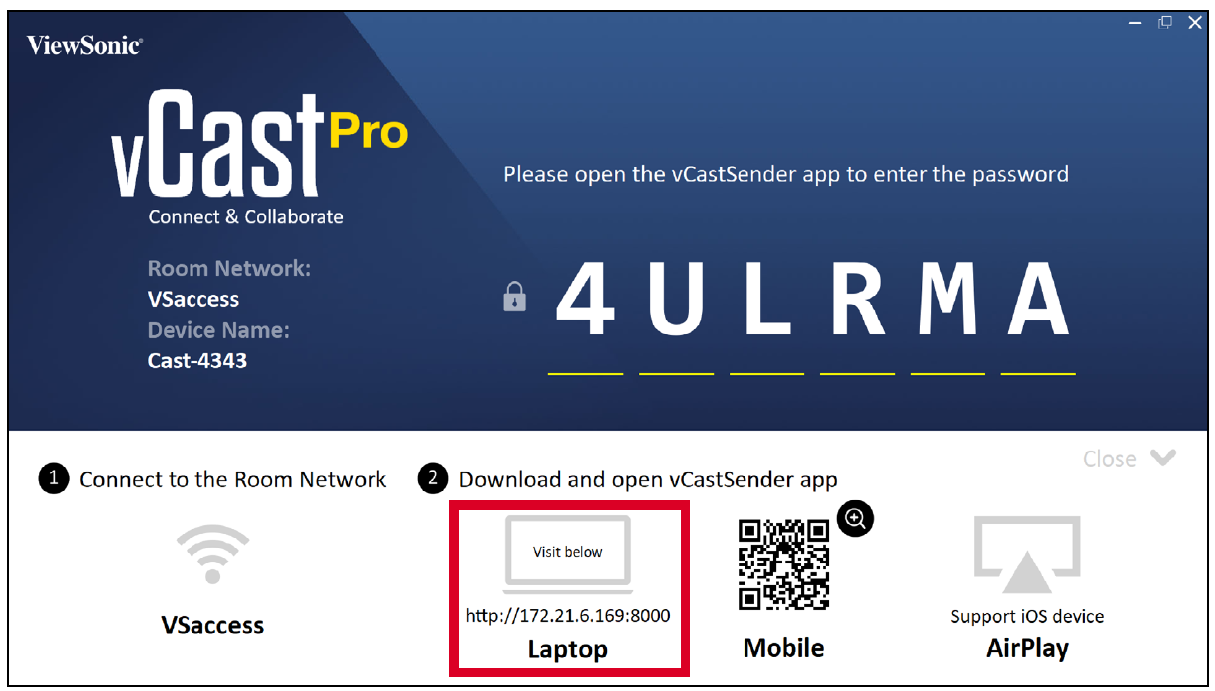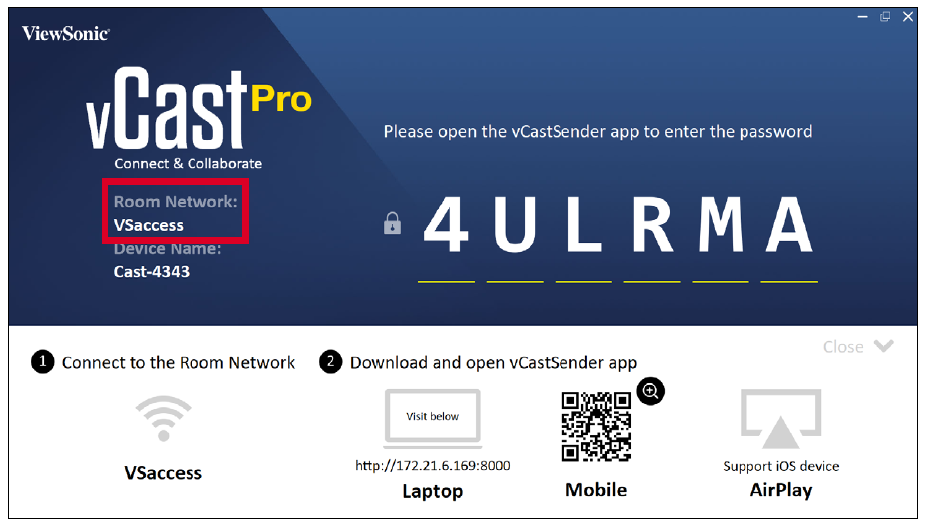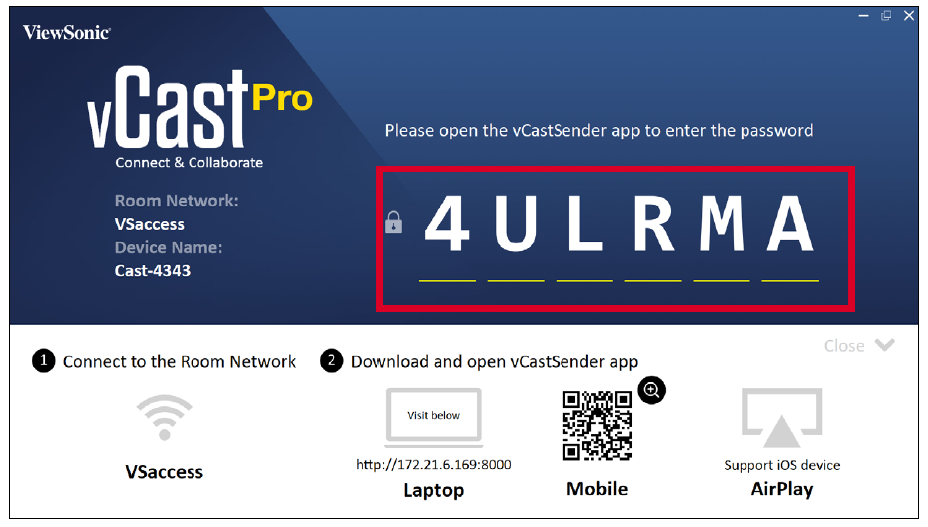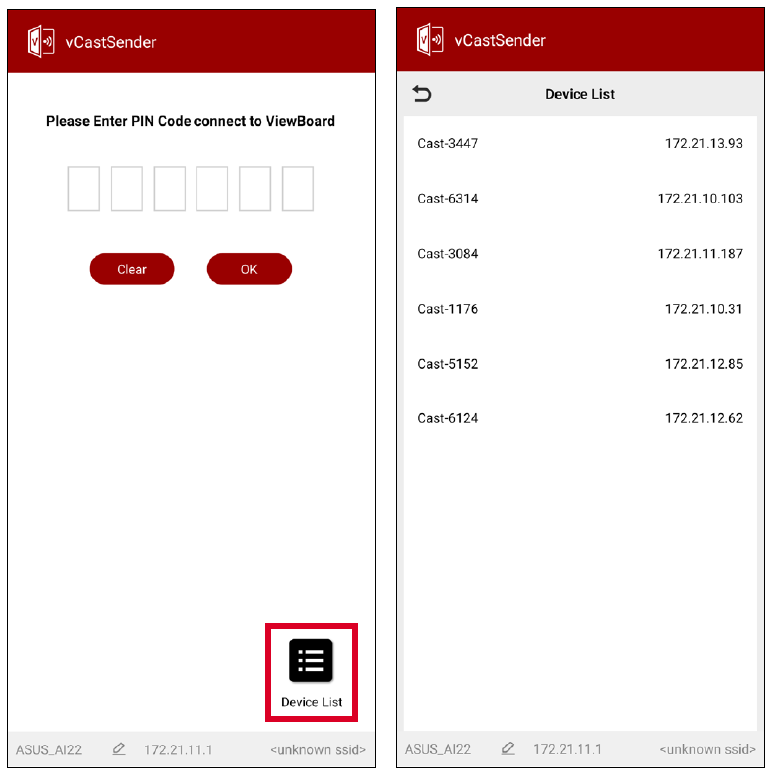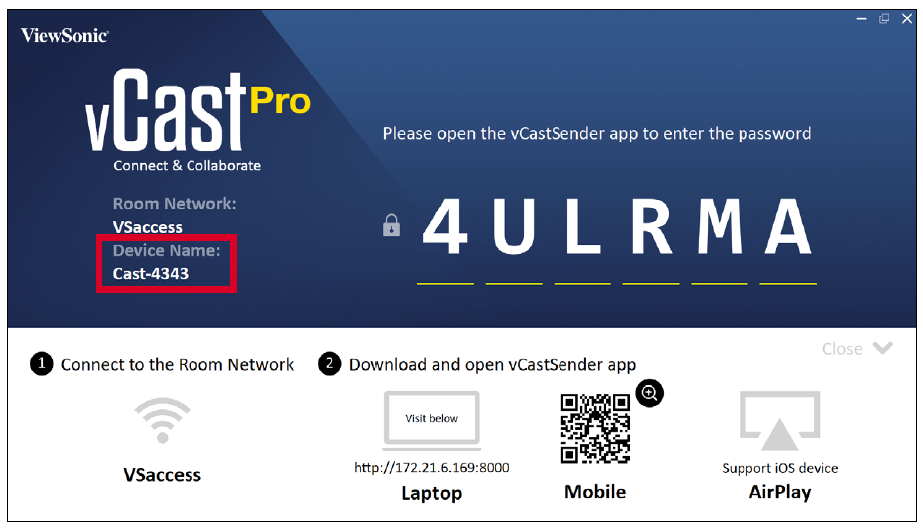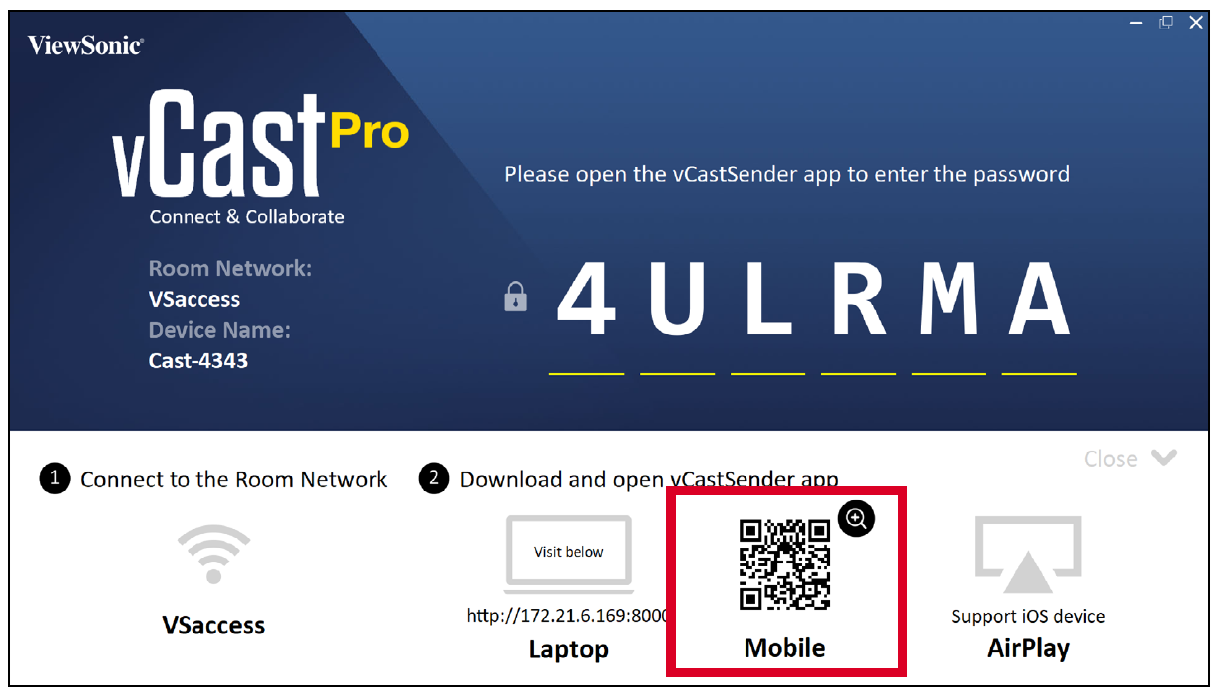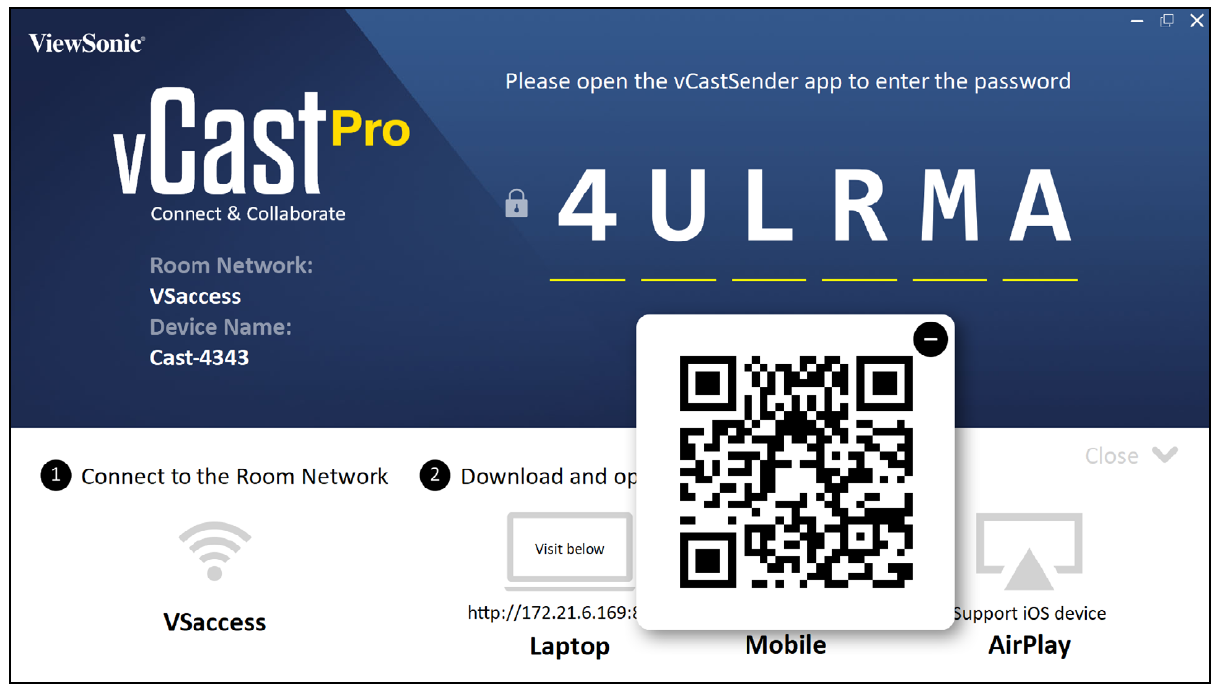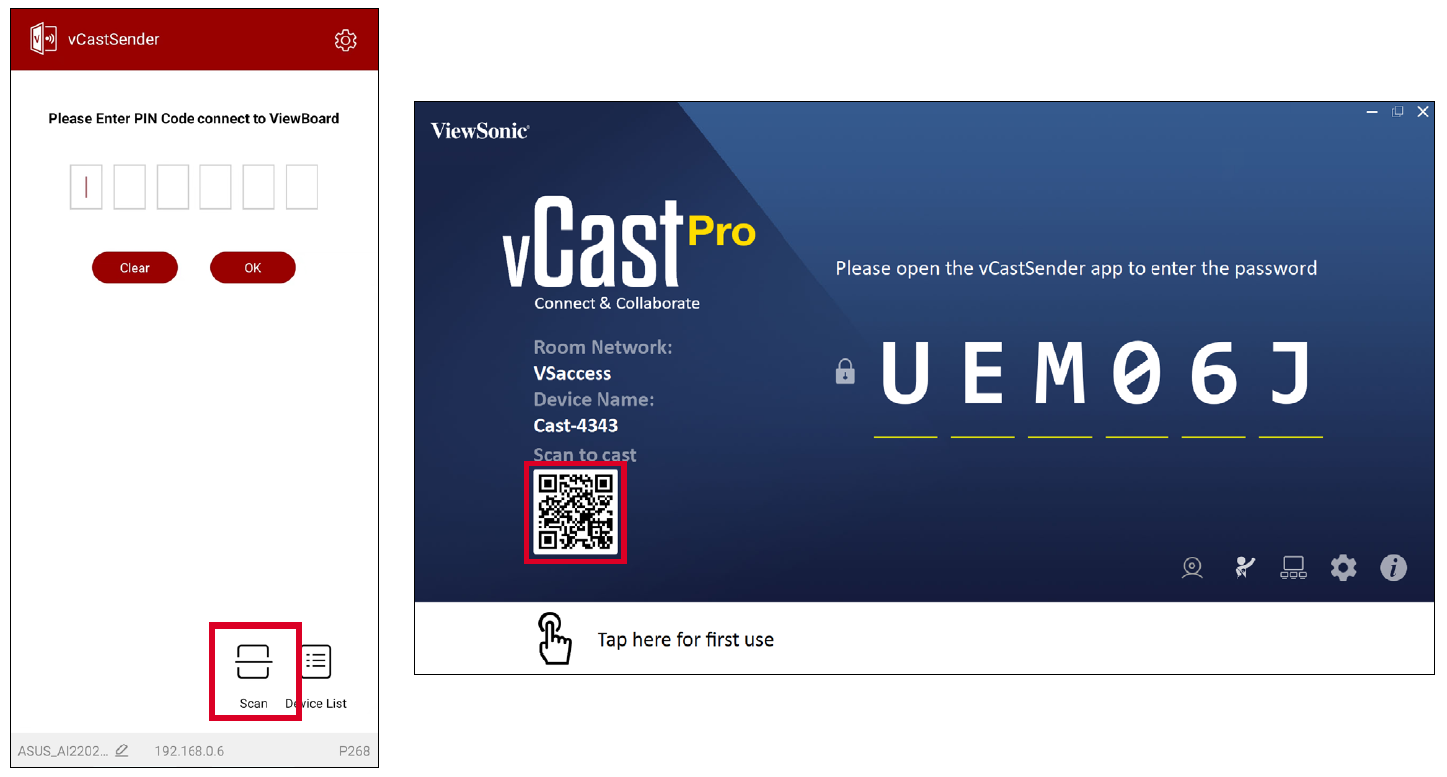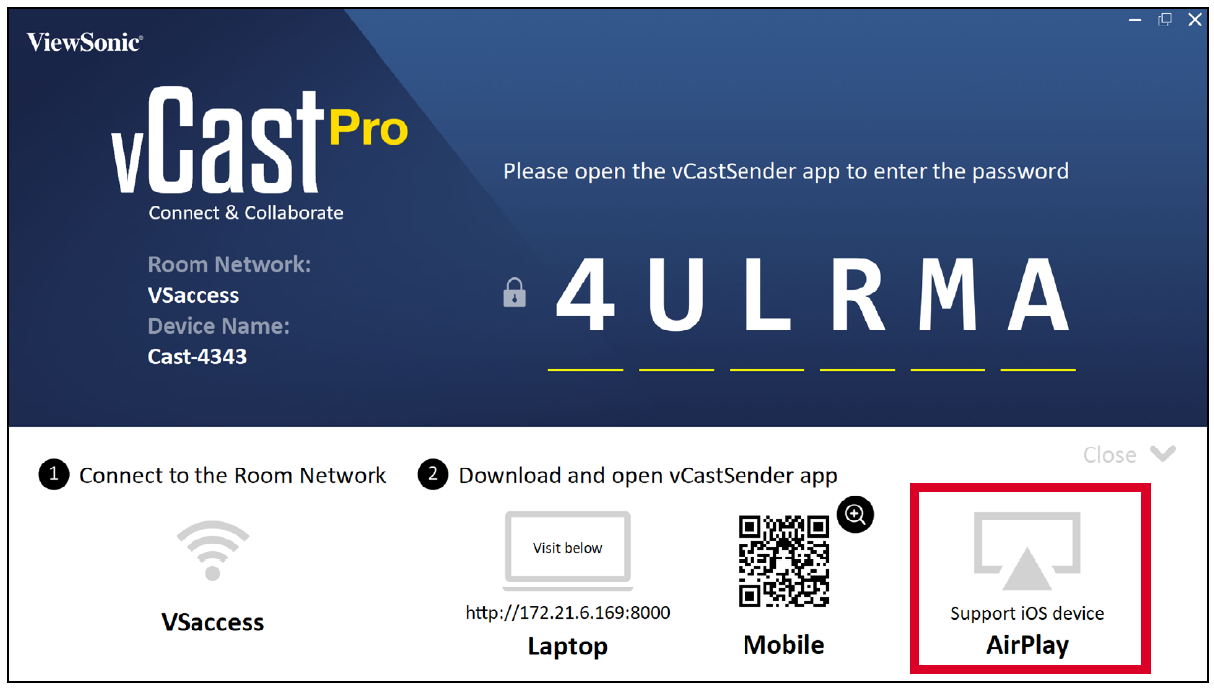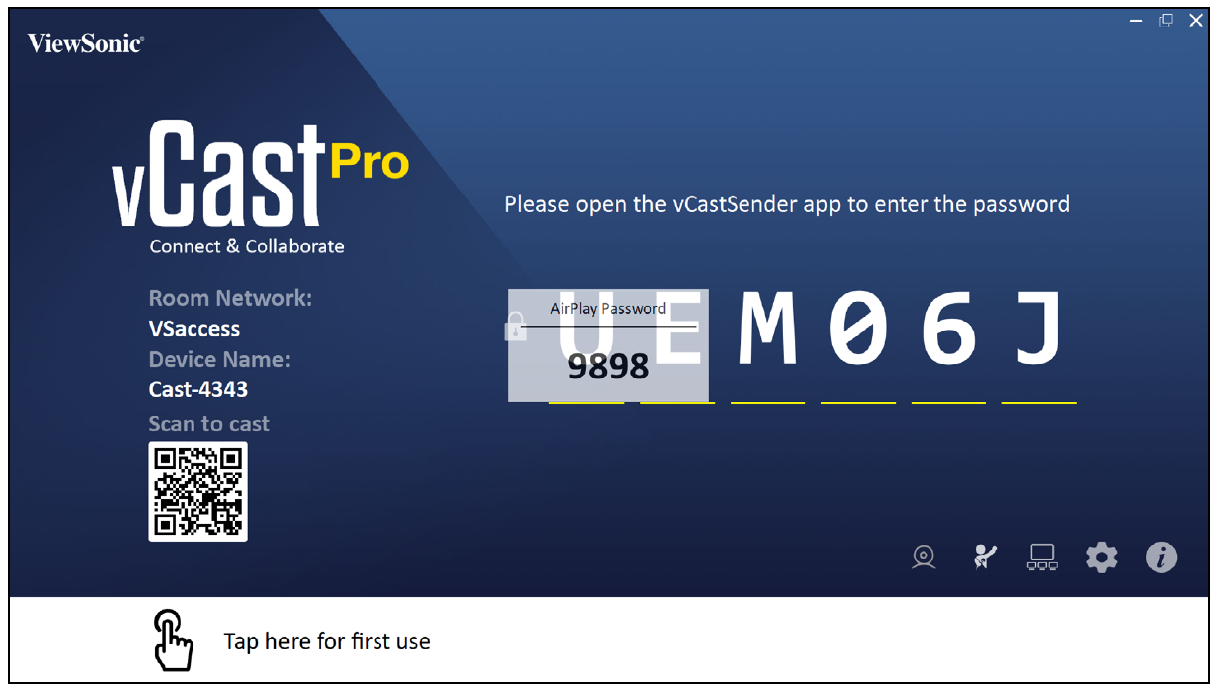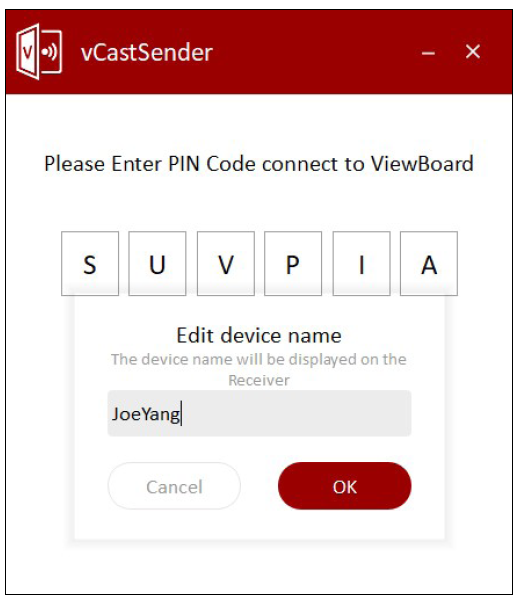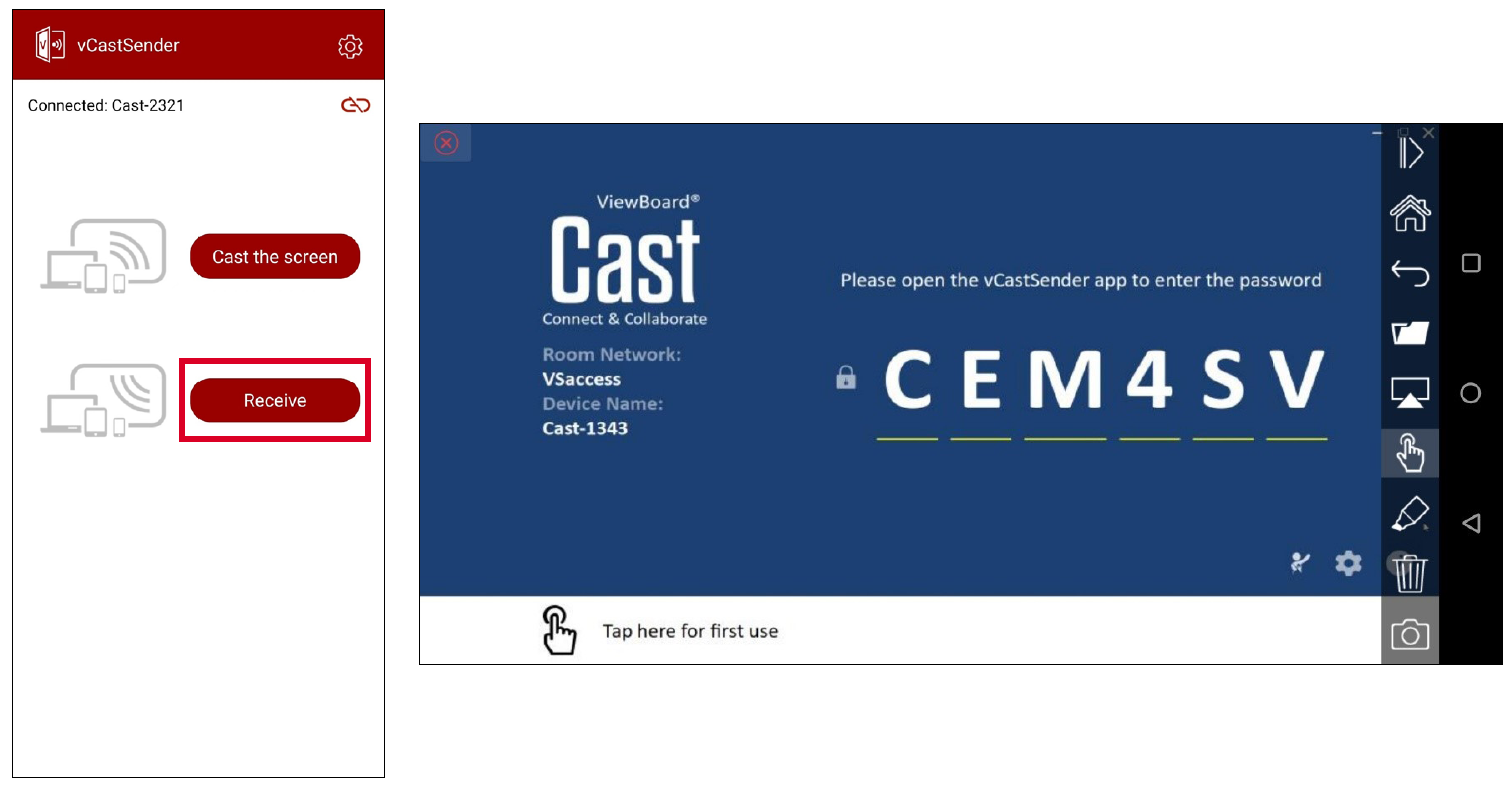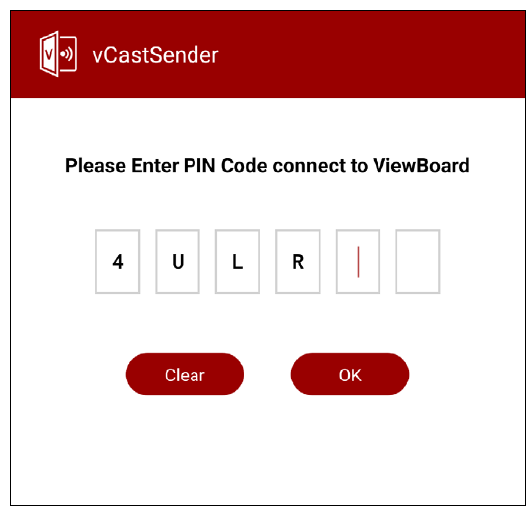vCast Pro
Introduction
vCast Pro software is designed for wireless presentations and collaboration.
Working with vCast Pro software and the vCastSender application allows you to stream live recordings, annotate, and share your screen, photos, videos, annotations, documents, and camera directly onto ViewSonic® ViewBoard® Interactive Flat Panels and other mobile devices. In addition, both advanced display group and moderator management functions are included.
Presenters can control displayed content from a phone, tablet, or laptop while Android and iOS device users are able to use vCastSender’s specialized annotation toolbar and control the ViewBoard® remotely. vCastSender's specialized moderation feature allows a moderator to take control of meetings or classrooms as well.
vCast Pro Features
Annotation and Collaboration
When viewing a presentation, users can annotate on the presenter’s display via Android/iOS pen tools.
Display Group
One to many casting feature that can reach up to six (6) displays and allow continuous group screen sync up.
Moderator Mode
The moderator has full control of a presentation session and can assign other participants to be the presenter or viewer. Additionally, the moderator can also broadcast a presentation cast to other connected devices and make annotations.
Multiple Screen Sharing
Multiple users can connect and display concurrently to the ViewBoard or display.
Remote View
Android/iOS users can view the screen of the current presenter on a ViewBoard or display.
Touchback Control
The current presenter can use touch control on the ViewBoard’s screen to remotely control casting devices.
- NOTE: The touchback control function is limited when using Chrome.
Wireless Display
Users can connect to the same network or cross subnet environments and display their personal screen to a ViewBoard or display.
This section covers information you need to know about the vCast Pro software requirements and installing it on a Windows PC device.
Requirements
Suggested Windows PC Hardware Specifications:
- Intel i3 series CPU (minimum)
- 4 GB RAM
PC Operation System Requirements:
- Wi-Fi capability - 2.4 GHz/5 GHz
- NOTE: a 5 GHz band will provide better wireless screen sharing performance.
- Microsoft® Windows 7, 8, 8.1, 10, 11
How to Launch vCast Pro
To launch vCast Pro:
- Select the vCast Pro application on the ViewBoard or display and open it.
- Ensure the ViewBoard or display is connected to a local network. The network name will be visible under Room Network.
- NOTE: For best performance, it is recommended to be connected to the local network via LAN by Ethernet cable.
- Once successfully launched you will see the below screen:
Cast Settings
To adjust the Cast Settings, select the Settings icon (![]() ) located in the lower-right corner of the screen.
) located in the lower-right corner of the screen.
| Item | Description |
|---|---|
| Device Name | Edit and set the Device Name for easier identification. |
| Connect Code | Select the refresh icon to generate a new code. |
| PIN Code Visible | Hide or show the vCast Pro connection PIN code on the screen. |
| Auto Start | When enabled, vCast Pro will launch automatically when you start your Windows PC. |
| Touch & Annotate from Mobile | Enable/disable the touch and annotate functions for mobile devices. |
| Open Moderator Mode by Default | When enabled, Moderator Mode will open by default. |
| Mult-Screen | Multiple users can wirelessly present to vCast Pro simultaneously. |
| AirPlay Service | When disabled, AirPlay Service will limit Apple iOS/MacOS devices to only see vCastPro device names for screen mirroring. |
| PIN Disable | When the PIN code is disabled, users on the same subnet network will be able to connect quicker.
|
Display Group Settings
To adjust the Display Group Settings, select the Display Group icon () located in the lower-right corner of the screen.
- Toggle the "Turn On/Off Display Group" ON to enable the Display Group feature.
- NOTE: Other preinstalled ViewBoard Cast devices in the same network will be listed.
- Select the devices you want to join the display group and select OK to save the settings.
- NOTE:
- If the devices you want to group are not listed, you can enter their respective IP address or connecting PIN code.
- The Display Group maximum device limit is six devices.
- If you frequently connect to the same device, you can select the Star icon (
) next to the device to add it to your frequently connected devices list, "My List of Devices in Group", for easier Display Group setup and management.
Synchronized Group Screen All the Time
When the “Synchronized group screen all the time” function is toggled ON, it will display a synchronized group screen continuously. If it is toggled OFF, it will work on vCast mirroring only.
- NOTE: Select the devices to group first, then toggle the "Synchronized group screen all the time” function ON to avoid interruption.
After confirming the above settings, you can share your screen to the main display, then the grouped client devices will be synced up to your screen.
Moderator Mode
Moderator Mode allows the moderator to take control of the devices connected to the ViewBoard or display. To enter Moderator Mode, select the Moderator Mode icon () located in the lower-right corner of the screen.
When enabled, the moderator can view a list of all connected screens in the left floating window and can preview each participant’s screen and then select any of participant’s screen and cast to the ViewBoard’s or display's main screen for presentation. The moderator can also control each participant’s screen, annotate on the ViewBoard or display, and remove unwanted participants by selecting the close icon (X).
Broadcast
When enabled, the ViewBoard’s or display's screen will be broadcasted to all of the participant’s connected screens simultaneously. The participants can only view the presentation contents until the moderator disables the Broadcast function.
Multiple Screen Sharing
By default, vCast Pro is set to allow multiple screen sharing, but can also be set to single screen sharing. To do this, the moderator can select the Multiple Screen Sharing icon to switch to single screen sharing.
Preview Screen
By default, vCast Pro is set to let the moderator preview the participant’s screen contents prior to sharing to the ViewBoard or display. Selecting the Preview Screen icon, the Moderator can switch to see the participant’s name only.
Touch
By default, participants can use touch for collaboration after connecting. The moderator can enable/disable the touch function of a participant by selecting the Touch icon in their window.
Annotate
Selecting the Annotate icon will list more annotation options:
 |
Move the Annotate toolbar on the screen. |
 |
Choose colors for annotations. |
 |
Clear annotations. |
 |
Save screen annotations to .png format. |
NOTE:
- Moderator Mode is supported on all vCastSender and AirPlay devices, but mobile devices are limited to a "preview" function. Additionally, mobile Android devices cannot cast sound out.
- When you cast your Windows/Mac/Chrome screen to a ViewBoard or display, the selected full screen unit will not be broadcasted back to your device to avoid repetitive screen casting.
- The active presenter can touch each of the participant's screens to remotely control casting devices.
- The number of multi-screen presenters on-screen depends on your Windows CPU processor performance and router specifications.
Casting to vCast Pro from a Client Device
Working with ViewBoard® Cast software (vCast, vCast Pro, and vCastSender), the vCast Pro application will allow the ViewBoard or display to receive laptop screens (Windows/Mac/Chrome) and mobile (iOS/Android) users’ screens, photos, videos, annotations, and camera(s) that are using the vCastSender application.
NOTE:
- ViewBoard® Cast software, laptops, and mobile devices can connect to both the same subnet and cross subnet by entering the on-screen PIN code.
- Connected devices will show up under Device List on the same subnet connection.
- If the device does not show up under Device List, users will need to key-in the on-screen PIN code.
- vCast Pro can setup “PIN disable” for a faster connection on the same subnet. Please note that the Remote Viewing function will be enabled if PIN code input is disabled.
Casting from Windows, MacBook, and Chrome Devices
- Ensure the client device (e.g., laptop) is connected to the same network as the ViewBoard or display.
- NOTE: The network name can be found under Room Network.
- On the client device, visit the address that is shown on the ViewBoard or display to download and install the vCastSender application.
- After installing, launch the vCastSender application.
- To connect to the ViewBoard or display, input the PIN code and click OK.
- NOTE: The PIN code can be found as highlighted below:
- Additionally, you can connect to the ViewBoard or display by clicking Device List then the Device Name listed.
- NOTE: The Device Name can be found as highlighted below:
Casting from Android Devices
- Ensure the client device (e.g., Android phone or tablet) is connected to the same network as the ViewBoard or display.
- NOTE: The network name can be found under Room Network.
- On the Android client device, scan the QR code shown on the ViewBoard or display to directly download the vCastSender application, or download the application from the Google Play Store.
- After installing, launch the vCastSender application.
- To connect to the ViewBoard or display, input the PIN code and click OK.
- NOTE: The PIN code can be found as highlighted below:
- You can also connect to the ViewBoard or display by clicking Device List then the Device Name listed.
- NOTE: The Device Name can be found as highlighted below:
- Additionally, you can connect to the ViewBoard or display by selecting Scan then placing the on-screen QR code into the box to automatically connect.
Casting from Apple iOS Devices
Apple AirPlay® is compatible with vCast Pro for screen mirroring and content streaming under the same subnet environment only. An “AirPlay Password” will be generated on-screen for connection when using AirPlay to cast to the ViewBoard or display.
- Ensure the client device (e.g., iPhone or iPad) is connected to the same network as the ViewBoard or display.
- NOTE: The network name can be found under Room Network.
- On the iOS client device, directly open AirPlay and select the Device Name of the ViewBoard or display to connect.
- NOTE: The Device Name can be found as highlighted below:
- Input the generated on-screen AirPlay Password on the client device to connect.
- NOTE: In a cross subnet environment, please download and connect with the vCastSender iOS application from the Apple App Store.
- You can also connect to the ViewBoard or display by selecting Scan then placing the on-screen QR code into the box to automatically connect.
Customize the Display Device's Device Name
vCastSender allows the customization of the device’s display name on vCast Pro.
Wireless Screen Sharing and Touchback Control
When connected to a ViewBoard or display from a Windows, MacBook, or Chrome device the vCastSender application for Windows/MacBook/Chrome client devices can wirelessly share their screen and use ViewBoard touchback control to control the device remotely.
Connecting to a ViewBoard or Display from Mobile Device
Once connected, select Receive. The ViewBoard or selected display screen will appear on the mobile device with an on-screen toolbar. Users can interact with the ViewBoard or display with annotations, file sharing, etc.
| Item | Description | |
|---|---|---|
| Toggle | Hide or display the toolbar. | |
| Home | Return to the Home interface. | |
| Return | Return to the previous operation. | |
| Folder | View or open the mobile device's files. | |
| Share | Cast the mobile device's screen to the connected ViewBoard or display. | |
| Touch | Remotely control the connected ViewBoard or display. | |
| Annotate | Make annotations, and adjust the pen color. | |
| Clear | Clear everything on screen. | |
| Camera | Send camera images to the connected ViewBoard or display. | |
Frequently Asked Questions
| Question | Answer |
|---|---|
| What is the minimum Wi-Fi signal strength for a reliable vCast Pro network? |
|
| What is the minimum video streaming network bandwidth recommended for reliable vCast Pro casting? |
|
| Will multiple screen casting cause latency issues, especially with video streaming content sharing? |
|
Troubleshooting
This section describes some common problems that you may experience when using vCast Pro. Additionally, you can contact your sales representative or IT department if you are experiencing any problems.
| Problem or Issue | Possible Solution |
|---|---|
| Device List is not displayed |
|
| Unable to connect to vCast Download page |
|
Network Information
vCast Pro & vCastSender Service
Network Information
- The ViewBoard and client devices can connect to both the same subnet and cross subnet. If on the same subnet, PIN code input can be disabled.
- vCast Pro supports cross subnet connectivity via PIN code input. Please ensure PIN code input is enabled. To learn more, see Cast Settings.
-
- NOTE: For a more stable connection, it is recommended to have any ViewBoard or display connected via LAN by Ethernet cable, and client devices on a 5 GHz Wi-Fi band.
- Ports:
- TCP 56789, 25123, 8121 & 8000 (Controlling message port & client device audio transfer)
- TCP 8600 (BYOM)
- TCP 53000 (Request share screen)
- TCP 52020 (Reverse control)
- TCP 52025 (Reverse control for ViewBoard Cast Button)
- TCP 52030 (Status sync)
- TCP 52040 (Moderator mode)
- UDP 48689, 25123 (Device searching and broadcast & client device audio transfer)
- UDP 5353 (Multicast search device protocol)
- Port and DNS Activation:
- Port: 443
- DNS: https://vcastactivate.viewsonic.com
- OTA Service
- Server Port: TCP 443
- Server FQDN Name: https://vcastupdate.viewsonic.com
AirPlay Service
- NOTE: Please ensure that mDNS is enabled on the network/access point/wireless controller (if applicable).
Network Information
- Ports
- TCP 51040, 51030, 51020 & 51010
- UDP 5353 (mDNS to broadcast Airplay)
- UDP random port with a range of 52000~53000 (Transfer audio; assigned by AirPlay protocol)
How to Verify AirPlay is Broadcasting
- Ensure that your iOS device and the ViewBoard or display are connected to the same subnet.
- Open the Control Center and select AirPlay Mirroring on the iOS device (e.g., iPhone/iPad).
- Find a device prefixed with “Cast-xxxx”.
- If “Cast-xxxx” is showing then this confirms that vCast is broadcasting AirPlay services.
- Click on the broadcasted “Cast-xxxx” device to mirror your iOS device to the ViewBoard.
Customer Service
vCast_Pro_UG_ENG_2a_20230905

